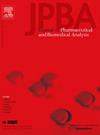Characterization of adeno-associated virus capsid proteins using denaturing size-exclusion chromatography coupled with mass spectrometry
IF 3.1
3区 医学
Q2 CHEMISTRY, ANALYTICAL
Journal of pharmaceutical and biomedical analysis
Pub Date : 2024-10-16
DOI:10.1016/j.jpba.2024.116524
引用次数: 0
Abstract
Recombinant adeno-associated viruses (AAVs) are a highly effective platform for gene delivery for the treatment of many human diseases. Characterization of AAV viral protein attributes (VP), such as serotype identity, VP stoichiometry, and VP post-translational modifications, is essential to ensure product and process consistency. While size-exclusion chromatography (SEC) coupled with mass spectrometry (MS) is commonly used in the biopharmaceutical industry for analyzing protein therapeutics, its application to intact AAV VP components has not gained traction, presumably due to difficulties in achieving adequate resolution of VP(1−3) monomers. Herein, we describe the development of a denaturing SEC method and optimization of SEC parameters, including stationary phase pore size, column temperature, and mobile phase composition, to achieve effective chromatographic separation of VP(1−3). We demonstrate that an optimized dSEC-MS method featuring MS-compatible formic acid, can effectively separate VP(1−3) across AAV1, 2, 5, 6, 8, and 9 serotypes using a single column and mobile phase condition. A case study was included to showcase successful application of the dSEC-MS method in analyzing changes across different AAV production processes, yielding similar conclusions to an orthogonal approach, such as hydrophilic interaction chromatography (HILIC)- MS. Additionally, dSEC integrated with fluorescence (FLR) and ultraviolet (UV) detection can be used to semi-quantitatively identify both AAV DNA and VP components from empty and full AAV samples. Overall, this robust and MS-friendly methodological advancement could greatly streamline the development and analytical quality control processes for AAV-based gene therapies, providing a highly sensitive method for intact VP characterization.
利用变性尺寸排阻色谱与质谱联用技术表征腺相关病毒荚膜蛋白质。
重组腺相关病毒(AAV)是治疗多种人类疾病的高效基因递送平台。AAV 病毒蛋白质属性(VP)的表征,如血清型特征、VP 的化学计量和 VP 翻译后修饰,对于确保产品和工艺的一致性至关重要。虽然生物制药行业通常使用尺寸排阻色谱法(SEC)结合质谱法(MS)来分析蛋白质疗法,但将其应用于完整的 AAV VP 成分的做法尚未得到推广,这可能是由于难以实现 VP(1-3) 单体的充分分辨。在此,我们介绍了变性 SEC 方法的开发和 SEC 参数的优化,包括固定相孔径、色谱柱温度和流动相组成,以实现 VP(1-3) 的有效色谱分离。我们展示了一种优化的 dSEC-MS 方法,该方法以与 MS 兼容的甲酸为特征,使用单一色谱柱和流动相条件就能有效分离 AAV1、2、5、6、8 和 9 血清型的 VP(1-3)。此外,dSEC 与荧光 (FLR) 和紫外线 (UV) 检测相结合,可用于半定量鉴定空 AAV 样品和完整 AAV 样品中的 AAV DNA 和 VP 成分。总之,这种稳健且便于 MS 分析的先进方法可大大简化基于 AAV 的基因疗法的开发和分析质量控制流程,为完整 VP 的表征提供了一种高灵敏度的方法。
本文章由计算机程序翻译,如有差异,请以英文原文为准。
求助全文
约1分钟内获得全文
求助全文
来源期刊
CiteScore
6.70
自引率
5.90%
发文量
588
审稿时长
37 days
期刊介绍:
This journal is an international medium directed towards the needs of academic, clinical, government and industrial analysis by publishing original research reports and critical reviews on pharmaceutical and biomedical analysis. It covers the interdisciplinary aspects of analysis in the pharmaceutical, biomedical and clinical sciences, including developments in analytical methodology, instrumentation, computation and interpretation. Submissions on novel applications focusing on drug purity and stability studies, pharmacokinetics, therapeutic monitoring, metabolic profiling; drug-related aspects of analytical biochemistry and forensic toxicology; quality assurance in the pharmaceutical industry are also welcome.
Studies from areas of well established and poorly selective methods, such as UV-VIS spectrophotometry (including derivative and multi-wavelength measurements), basic electroanalytical (potentiometric, polarographic and voltammetric) methods, fluorimetry, flow-injection analysis, etc. are accepted for publication in exceptional cases only, if a unique and substantial advantage over presently known systems is demonstrated. The same applies to the assay of simple drug formulations by any kind of methods and the determination of drugs in biological samples based merely on spiked samples. Drug purity/stability studies should contain information on the structure elucidation of the impurities/degradants.

 求助内容:
求助内容: 应助结果提醒方式:
应助结果提醒方式:


